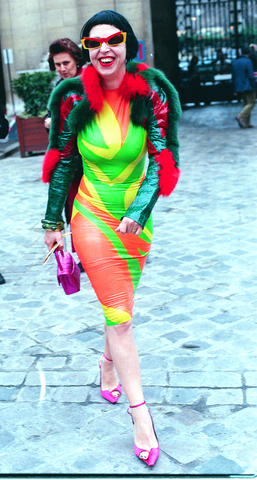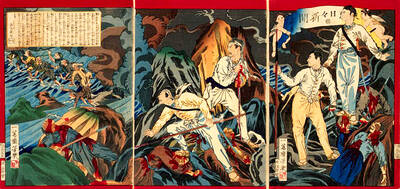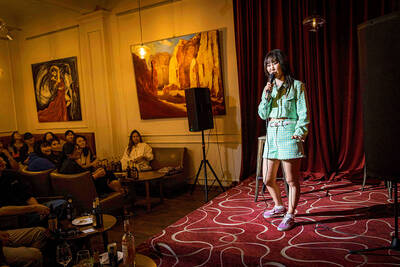Isabella Blow, one of the most unforgettably original and eccentric figures on the international fashion scene, died Monday in hospital at the age of 48.
"She will leave a gaping hole in the fashion world," said Geordie Greig, editor of the society magazine Tatler, where she had been fashion director for six years. "She was just one of the brightest stars in the fashion world, the funniest, the most original, the kindest. She was one of those people who breathed life into a room, her energy was electric. She didn't do dull, she didn't do unoriginal — she was always just dazzlingly imaginative, creative, unexpected."
Born Isabella Delves Broughton, confessing to a childhood ambition to be a nun, and improbably trained as a secretary, she seemed a figure from the golden age of British eccentricity who could have taken tea with the Sitwells and the Mitfords without the seams showing. She came from a famously eccentric family, but was credited with a remarkably shrewd eye for contemporary fashion.

PHOTO: NY TIMES NEWS SERVICE
She helped launch the careers of designers such as Julien MacDonald, and many models, including Honor Fraser, Stella Tennant and Sophie Dahl, whom she called "a blow-up doll with brains".
Harriet Quick, Vogue's fashion features director, said: "She was an incredibly important figure in the fashion world. Many of today's most celebrated designers will look back on her as a real hero because, with her energy and spirit, she encouraged them to develop their ideas. She very much embodied that moment in the 1990s when British fashion was going through a period of real strength and it was partly thanks to her that British fashion became so visible at that time. You couldn't ignore her on the front row."
Blow was rarely seen in public without a striking hat by Philip Treacy, whose work she championed from the time he brought an acid green felt, with jagged crocodile teeth edges, into the Tatler office.
Treacy said last night: "It was easy to think of her as some unusual looking person in a hat, but there was much more to her than that. She was the most interesting person I ever met. She was highly intelligent, highly cultured, she loved talent, especially talent in young people. She often saw herself as a piglet looking for truffles — we were all truffles to her, me, Alexander McQueen, Stella Tennant, Sophie Dahl, all of us.
"She was the first truly English person I met when I came over here [from Ireland]. I couldn't quite believe her, and in 20 years when I have done everything and met everyone there is to meet, nobody beat Isabella. She was a very kind person, with a really big heart, incredibly generous of her time and anything else she had. She was a breath of fresh air, all the beauty, elegance and glamour that fashion should be."
Treacy lived for two years in her mother-in-law's basement flat, and she commissioned his first wedding hat, for her wedding to the artist Detmar Blow in 1989. In 2002 her vast collection of his hats, including one that moved every time she spoke and one with 100 veils made for the funeral of a cousin so that the veiling would absorb the tears, became the subject of an exhibition at the London Design Museum, and a book, When Philip Met Isabella.
She was also admirer, muse and freelance publicist to Alexander McQueen, encouraging his work from student days until his present stellar heights.
They first met at his degree show at St Martin's, where he offered to sell her a coat for ?350, and she ended up buying the entire collection for ?5,000.
Blow's family had been country landowners for 600 years, but her grandfather, Sir Jock Delves Broughton, sold most of it to pay gambling debts. He moved to Kenya where he was acquitted of murdering Lord Erroll, but later killed himself — the White Mischief scandal, the subject of innumerable articles, books and a film.
In 1981, having abandoned her studies of Ancient Chinese Art at Columbia University, she worked briefly for the designer Guy Laroche before being introduced by Bryan and Lucy Ferry to Anna Wintour, then fashion director of US Vogue; she later claimed they bonded over a shared love of the work of Vita Sackville-West. She became a personal assistant, then a stylist and commissioner of fashion shoots at Vogue, and then returned to London where she worked on British Vogue and became fashion director at the Sunday Times and later Tatler.
Her final year proved to be a difficult time; she was frequently depressed and had only recently discovered that she had cancer. Her downtime was at home in Gloucestershire, Greig said. "She was a real country girl at heart, just as happy going for a walk in gumboots and a hat as on the front row in Paris or New York."

In the March 9 edition of the Taipei Times a piece by Ninon Godefroy ran with the headine “The quiet, gentle rhythm of Taiwan.” It started with the line “Taiwan is a small, humble place. There is no Eiffel Tower, no pyramids — no singular attraction that draws the world’s attention.” I laughed out loud at that. This was out of no disrespect for the author or the piece, which made some interesting analogies and good points about how both Din Tai Fung’s and Taiwan Semiconductor Manufacturing Co’s (TSMC, 台積電) meticulous attention to detail and quality are not quite up to

April 21 to April 27 Hsieh Er’s (謝娥) political fortunes were rising fast after she got out of jail and joined the Chinese Nationalist Party (KMT) in December 1945. Not only did she hold key positions in various committees, she was elected the only woman on the Taipei City Council and headed to Nanjing in 1946 as the sole Taiwanese female representative to the National Constituent Assembly. With the support of first lady Soong May-ling (宋美齡), she started the Taipei Women’s Association and Taiwan Provincial Women’s Association, where she

It is one of the more remarkable facts of Taiwan history that it was never occupied or claimed by any of the numerous kingdoms of southern China — Han or otherwise — that lay just across the water from it. None of their brilliant ministers ever discovered that Taiwan was a “core interest” of the state whose annexation was “inevitable.” As Paul Kua notes in an excellent monograph laying out how the Portuguese gave Taiwan the name “Formosa,” the first Europeans to express an interest in occupying Taiwan were the Spanish. Tonio Andrade in his seminal work, How Taiwan Became Chinese,

Mongolian influencer Anudari Daarya looks effortlessly glamorous and carefree in her social media posts — but the classically trained pianist’s road to acceptance as a transgender artist has been anything but easy. She is one of a growing number of Mongolian LGBTQ youth challenging stereotypes and fighting for acceptance through media representation in the socially conservative country. LGBTQ Mongolians often hide their identities from their employers and colleagues for fear of discrimination, with a survey by the non-profit LGBT Centre Mongolia showing that only 20 percent of people felt comfortable coming out at work. Daarya, 25, said she has faced discrimination since she